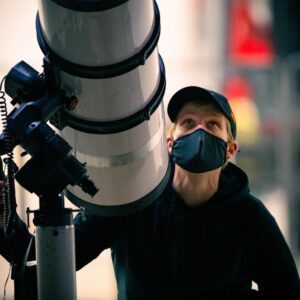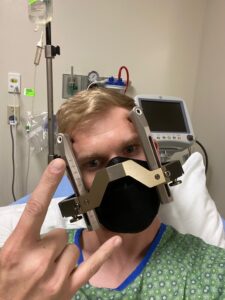
Rare Community Profiles is a Patient Worthy article series of long-form interviews featuring various stakeholders in the rare disease community, such as patients, their families, advocates, scientists, and more.
The Monster Inside: How a Boundary-Breaking Treatment Helped Sean in His Battle with von Hippel-Lindau Syndrome (VHL)
Today, Sean K. is thriving. A Director of Photography for a cybersecurity firm by day, Sean is an amateur astronomer and astrophotographer by night—most recently, his overnight time-lapse venture led him to capture a dizzyingly beautiful expression of the Northern Lights. In his spare time, Sean teaches an astrophotography course at Colorado State University and acts on the Board of Directors for a nonprofit focused on community development in rural Uganda.

Years ago, Sean never expected to be at this point. Grappling with pervasive health challenges that first reared their head in 2007, when Sean was a junior studying mechanical engineering, left the future feeling altogether uncertain.
At first, his grades began to slip. Sean wasn’t entirely concerned; he attributed it to the complexities of mechatronics and material science, topics he was still working on wrapping his head around. But when his right arm became intermittently numb, and he began experiencing nausea every morning, it wasn’t as easy to write them off.
The numbness worsened, but specialists had no answers. The most likely answer, they said, was a pinched nerve in the neck. Nothing to worry about. It wasn’t until a radiologist saw the necessity of performing a brain MRI that answers finally emerged. That same afternoon, Sean says:
“They called to tell me that I had a tumor on the base of my brain stem and a cyst the size of a golf ball.”
Two days later, during surgery, the doctor realized that what Sean had was not a solid mass but a blood vessel tumor; cutting into it created a (momentarily) chaotic moment where physicians had to respond rapidly to stop Sean’s excessive bleeding. By the end of the surgery, Sean says:
“I was almost dead and fully paralyzed on my right side. They had to pump me full of blood. My parents were terrified.”
But it was the sight of the blood vessel tumor that provided answers, that made the physician believe that Sean had a rare genetic condition. Further testing gave insight: von Hippel-Lindau syndrome (VHL).
What is von Hippel-Lindau Syndrome (VHL)?
Prior to his diagnosis, Sean had never before heard of VHL—and there was no family history, leaving him searching for answers.
Von Hippel-Lindau syndrome is a rare genetic disorder caused by VHL gene mutations. While VHL is inherited in around 80% of cases, 20% of those affected, like Sean, have no prior family history. The genetic mutations cause vascular tumors and cysts to form throughout the body, often in the retina, spine, kidneys, pancreas, brain, inner ear, adrenal glands, or genital tract. People with VHL may experience tumors in up to ten different bodily areas at once. Although many VHL-associated tumors are benign, they can be cancerous. Benign tumors can also have significant health impacts.
This condition normally manifests in someone’s early 20s but can occur earlier or later in life. Because manifestations differ so vastly, physicians should monitor individuals with VHL through life. The most common sign of VHL is hemangioblastomas in the retina, spine, or brain. If someone presents with multiple hemangioblastomas in these areas, physicians should consider testing for VHL. Hemangiomas, if they press on surrounding nerves and tissue, can lead to poor balance and coordination, arm/leg weakness, headaches, vision impairment, and floaters.
Other manifestations vary based on the tumor’s location. Heavy sweating, panic attacks and anxiety, and high blood pressure are linked to adrenal tumors. Retinal tumors can cause blindness, and inner ear tumors can lead to balance and hearing loss. Pancreatic tumors can lead to gastrointestinal distress or disrupted bowel and bladder function. VHL is also associated with a higher risk of pancreatic neuroendocrine tumor and renal cell carcinoma development.
A Monster in Wait
When Sean received his diagnosis, he was shocked. The physicians he spoke with didn’t really understand what VHL was, and specialists wanted to dive in and perform surgery without really knowing what impact VHL had on his body.
His saving grace was a website, phone number, and packet of information on VHL from the VHL Alliance, a 501(c)(3) nonprofit organization set up to support patients, families, and caregivers in the von Hippel-Lindau syndrome community. The VHL Alliance provides unique resources and can help patients with VHL find doctors or local clinical care centers.

This gave Sean valuable connections to others who understood what he was going through while also allowing him to use his skill set to perform outreach. In 2015, the VHL Alliance asked Sean to collaborate with them on a video to spur specialist inclusion in VHL care. The video they co-developed was crucial in leveraging specialist connections to develop a critical care center within Sean’s hospital for VHL patients.
The VHL Alliance also provided Sean with a welcome sense of community and other de novo patients who understood the mental and emotional toll this diagnosis caused. When you’re diagnosed with a rare disease, it can be easy to compartmentalize or to isolate yourself. Says Sean:
“I didn’t want to scare my family or my friends. Finding other VHL patients was the key to me breaking free of the hold that VHL had on me. I found kindred spirits in that army of VHL patients who were willing to get scared and go through the dark times with me. For individuals who are newly diagnosed and don’t know where to go, reach out to the VHL Alliance. They are the best resource you can find for information and support, including monthly caregiver calls and patient support groups. I am so grateful for the VHL Alliance for the work that they do and the sense of community they have cultivated.
As I look back, I’d also encourage people to not necessarily take the path I took in shielding my friends and family. Talk to them; let them know how you feel. Build that army up.”
Despite his new wealth of information and his relationship with the VHL Alliance, Sean still struggled with what having VHL meant for his life. No matter what treatments he pursued, there seemed to be little change in his health outlook between the time of his diagnosis and 2020. He explains:
“For the longest time, VHL was a monster lying in wait in a cave. I knew it could show up in my body in ten different places, but I didn’t know when, where, or how severe. The monster reared its head pretty frequently, mostly in my brain. I had forty total brain tumors irradiated through stereotactic radiosurgery. But the monster also appeared elsewhere: solid masses in my kidneys that were diagnosed as kidney cancer, three spinal tumors, and pancreatic tumors.”
But as 2021 appeared on the horizon, hope suddenly broke through the clouds—and Sean felt like his future might be brighter than he had ever imagined.
Welireg: The Tool Used in Battle
For months, Sean had seen whispers on the Facebook groups about a groundbreaking drug in development for von Hippel-Lindau syndrome: Welireg (belzutifan). Dr. Eric Jonasch, MD, of the VHL Alliance played an integral role in developing Welireg.
After it succeeded in Phase 2 clinical studies, the FDA approved the treatment on August 13, 2021. Sean immediately called his urologist, who is his main oncologist, to get on the treatment. By October 21, 2021, Sean says:
“I gained access to Welireg and shined a light in that cave. Like many other people living with VHL, I no longer fear the monster that exists within me. Welireg has essentially quelled the beast. I used to wake up in cold sweats, panicked, thinking there was nothing I could do to help myself. That my genetic cancer would continue causing hell in my life. I couldn’t imagine what it would do to my body, my relationships, my job, or other facets of my life over time. And my past treatment plan was reactive—they would find tumors and treat them when they got big enough, so I was always worrying about where the tumors were manifesting. Now we’re in a preventative state where tumors do not even form. I no longer live with fear.”
The impact of treatment was swift. Within six months of starting Welireg, the solid mass lesions in Sean’s kidney had all but disappeared. His spinal cancers shrunk. Even more stunningly, Sean has seen a 67% reduction in the eleven small brain lesions he had prior to treatment. As he reflects, Sean muses with a smile:
“This treatment is a game-changer. It’s a life changer. After three years, I really cannot put into words what it has done for me and what it is doing for other patients.”
Making a Difference
To Sean, sharing his story presents the ideal way to get in front of other people with VHL and say: You are not alone and your life is not over. He’s already found that being open about his journey has given him the opportunity to connect and find hope with others dealing with chronic conditions. Whether it’s a friend’s cousin in India who was recently diagnosed with VHL or a new friend and breast cancer survivor that he met in the documentary space, each interaction he has and story he hears enriches his life in ways that are almost unexplainable.
But his path is not over, and Sean now feels called to support his community in advocating for their own wellbeing. He notes that physicians often jump to conclusions, especially around the words “genetic” and “cancer,” and reminds others with VHL to always speak up for themselves; after all, they know their body the best.
Sean recalls how after his first brain tumor, he spent 22 days in the hospital. Around day 10, he began experiencing cerebral salt wasting. His brain was dumping sodium into the cells of his body, leading to a variety of symptoms and near-epileptic episodes. The endocrinologist thought Sean had pheochromocytomas:
“He did scans and couldn’t see them, but swore they were there, and I would need surgery to get them out. Something felt off to me. I called my doctor in my rural Colorado hometown, who urged me to get a second opinion. My second opinion told me, ‘You just had a brain tumor. Everything in your body is crazy right now. Give it a few months.’ And guess what? No pheochromocytoma. Doctors know a lot and are there to help you, but with a rare disease, you tend to know more about your body. If you feel something is off, talk to your doctor. Ask questions. You’re not bothering your doctors and if you don’t agree with them, you can find someone else who can help. But this experience really underscored how, as a VHL patient, you are your best advocate.”
Looking for more information on VHL? Check out the VHL Alliance. They are here to help.


